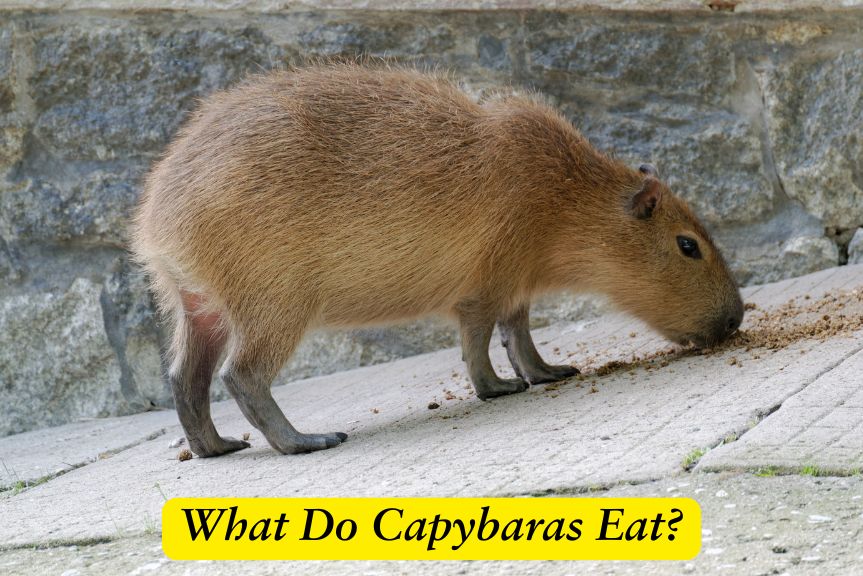Capybaras are the world’s biggest rodents but have a fascinating diet. Their eating habits are shaped by their physical needs and habitat since they live in wetlands all across South America. What capybaras eat provides insights into their survival strategies, health, and unique adaptations.

Due to their semi-aquatic nature, capybaras rely on terrestrial and aquatic plants for their diet, supporting their digestive health as herbivorous grazers. Because they are semi-aquatic, they eat both land and aquatic plants. Fiber is essential in maintaining digestive efficiency, vital to their health.
Key Nutritional Requirements
- Fiber: Digestion and gut health are dependent on it.
- Protein: Growing capybaras require calcium for growth and maintenance.
- Vitamins and Minerals: Supports overall health, strong bones, and a robust immune system.
- Primary Components of a Capybara’s Diet
A capybara’s diet depends on seasonal Availability, but several food sources remain consistent:
Grasses
They feed on several grass species throughout the year but are particularly fond of those growing near water bodies. The fiber found in grass provides the necessary fuel for their complex digestive system.
- Primary Types: Bermuda grass, water hyacinth, and other aquatic grasses.
- Benefits: Grass aids in dental health by naturally wearing down their continuously growing teeth.
- Aquatic Plants
In dry seasons, capybaras consume aquatic plants in wetland habitats. These plants provide water, which helps them stay hydrated.
- Types Consumed: Water lilies, duckweed, and pondweed.
- Seasonal Role: Aquatic plants become particularly crucial when other food sources are scarce.
- Fruits and Vegetables
A capybara occasionally eats fruits and vegetables, particularly in captivity or near farmlands. They supply a variety of nutrients and serve as a supplement to their primary diet.
- Examples: Squash, apples, melons, and carrots.
- Moderation: High sugar content in fruits means capybaras consume them sparingly.
- Tree Bark and Reeds
In dry periods, when grasses and other primary food sources are limited, capybaras rely on tree bark and reeds, which are difficult to digest but provide essential nutrients.
- Types: Willow and cattail bark.
- Purpose: Provides fiber and helps with the natural wearing of teeth.
- Unique Digestive Adaptations in Capybaras
Coprophagy is a digestive adaptation that allows capybaras to extract additional nutrients and bacteria to digest fibrous foods.
Seasonal Variations in Capybara Diet
Capybaras adapt their diet based on seasonal Availability to thrive throughout the year, particularly in regions with distinct wet and dry seasons.
Wet Season Diet
Fresh grass, aquatic plants, and lush vegetation are abundant during the wet season, so capybaras can meet their dietary needs without using fallback foods.
Dry Season Diet
Capybaras use coprophagy to extract nutrients from limited resources when water levels fall and vegetation declines. Their diet becomes more resilient as reeds grow and bark becomes scarce.
- Capybara Diet in Captivity
It is carefully managed in captivity to mimic the diet of capybaras as closely as possible. A mix of grass, hay, and pellets is provided in zoos and sanctuaries. As a treat, fresh fruits and vegetables are occasionally offered.
Nutritional Management
- Primary Foods: Timothy hay, alfalfa, and grass-based pellets.
- Supplements: Vitamin-enriched pellets ensure capybaras receive a balanced diet.
- Treats: Limited amounts of fruits like apples and melons to prevent overconsumption of sugar.
- Health Implications of Diet
Maintaining a natural diet is vital to preserve capybaras’s health. Any deviation can lead to obesity, dental problems, and digestive disorders. Consistent access to fibrous foods and sufficient water helps prevent these risks.
1 thought on “What Do Capybaras Eat? A Comprehensive Guide to the Capybara Diet”